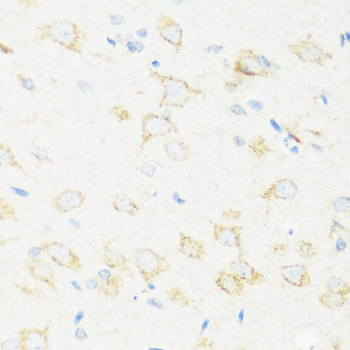Cell Biology Antibodies 13
Anti-ASIC4 Antibody (CAB17179)
- SKU:
- CAB17179
- Product Type:
- Antibody
- Reactivity:
- Rat
- Host Species:
- Rabbit
- Isotype:
- IgG
- Antibody Type:
- Polyclonal Antibody
- Research Area:
- Cell Biology
Description
| Antibody Name: | Anti-ASIC4 Antibody |
| Antibody SKU: | CAB17179 |
| Antibody Size: | 20uL, 50uL, 100uL |
| Application: | IHC |
| Reactivity: | Rat |
| Host Species: | Rabbit |
| Immunogen: | Recombinant fusion protein containing a sequence corresponding to amino acids 350-460 of human ASIC4 (NP_878267.2). |
| Application: | IHC |
| Recommended Dilution: | IHC 1:50 - 1:200 |
| Reactivity: | Rat |
| Positive Samples: |
| Immunogen: | Recombinant fusion protein containing a sequence corresponding to amino acids 350-460 of human ASIC4 (NP_878267.2). |
| Purification Method: | Affinity purification |
| Storage Buffer: | Store at -20°C. Avoid freeze / thaw cycles. Buffer: PBS with 0.02% sodium azide, 50% glycerol, pH7.3. |
| Isotype: | IgG |
| Sequence: | GLEI MLDI QQEE YLPI WRET NETS FEAG IRVQ IHSQ EEPP YIHQ LGFG VSPG FQTF VSCQ EQRL TYLP QPWG NCRA ESEL REPE LQGY SAYS VSAC RLRC EKEA VLQR CHC |
| Gene ID: | 55515 |
| Uniprot: | Q96FT7 |
| Cellular Location: | |
| Calculated MW: | |
| Observed MW: | Refer to figures |
| Synonyms: | ASIC4, ACCN4, BNAC4 |
| Background: | This gene belongs to the superfamily of acid-sensing ion channels, which are proton-gated, amiloride-sensitive sodium channels. These channels have been implicated in synaptic transmission, pain perception as well as mechanoperception. This gene is predominantly expressed in the pituitary gland, and was considered a candidate for paroxysmal dystonic choreoathetosis (PDC), a movement disorder, however, no correlation was found between mutations in this gene and PDC. |
| UniProt Protein Function: | ASIC4: Probable cation channel with high affinity for sodium. In vitro, has no proton-gated channel activity. Belongs to the amiloride-sensitive sodium channel (TC 1.A.6) family. ASIC4 subfamily. 3 isoforms of the human protein are produced by alternative splicing. |
| UniProt Protein Details: | Protein type:Membrane protein, multi-pass; Transporter, ion channel; Channel, sodium; Transporter; Membrane protein, integral Chromosomal Location of Human Ortholog: 2q35 Cellular Component: integral to plasma membrane Molecular Function:ion channel activity; sodium ion transmembrane transporter activity Biological Process: transport |
| NCBI Summary: | This gene belongs to the superfamily of acid-sensing ion channels, which are proton-gated, amiloride-sensitive sodium channels. These channels have been implicated in synaptic transmission, pain perception as well as mechanoperception. This gene is predominantly expressed in the pituitary gland, and was considered a candidate for paroxysmal dystonic choreoathetosis (PDC), a movement disorder, however, no correlation was found between mutations in this gene and PDC. [provided by RefSeq, Feb 2012] |
| UniProt Code: | Q96FT7 |
| NCBI GenInfo Identifier: | 296434387 |
| NCBI Gene ID: | 55515 |
| NCBI Accession: | Q96FT7.2 |
| UniProt Secondary Accession: | Q96FT7,Q53SB7, Q6GMS1, Q6PIN9, Q9NQA4, |
| UniProt Related Accession: | Q96FT7 |
| Molecular Weight: | 72,190 Da |
| NCBI Full Name: | Acid-sensing ion channel 4 |
| NCBI Synonym Full Names: | acid sensing ion channel subunit family member 4 |
| NCBI Official Symbol: | ASIC4 |
| NCBI Official Synonym Symbols: | ACCN4; BNAC4 |
| NCBI Protein Information: | acid-sensing ion channel 4 |
| UniProt Protein Name: | Acid-sensing ion channel 4 |
| UniProt Synonym Protein Names: | Amiloride-sensitive cation channel 4; Amiloride-sensitive cation channel 4, pituitary |
| Protein Family: | Acid-sensing ion channel |
| UniProt Gene Name: | ASIC4 |
| UniProt Entry Name: | ASIC4_HUMAN |







